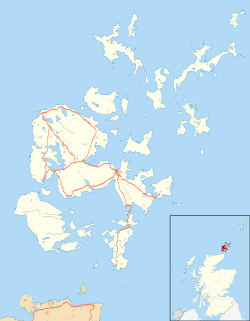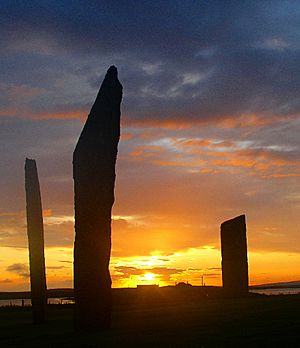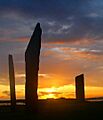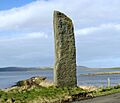Stones of Stenness facts for kids
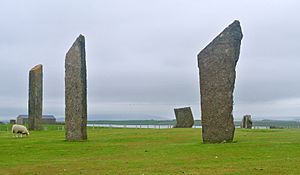
The Standing Stones of Stenness
|
|
| Location | Mainland, Orkney |
|---|---|
| Region | Scotland |
| Coordinates | 58°59′38″N 3°12′28″W / 58.99398°N 3.20775°W |
| Type | Standing stones |
| History | |
| Periods | Neolithic |
| Site notes | |
| Ownership | Historic Environment Scotland |
| Public access | Yes |
| Type | Cultural |
| Criteria | i, ii, iii, iv |
| Designated | 1999 (23rd session) |
| Part of | Heart of Neolithic Orkney |
| Reference no. | 514 |
| State Party | Scotland |
| Region | Europe and North America |
| Identifiers | |
| Historic Environment Scotland | SM90285 |
The Standing Stones of Stenness are an ancient monument from the Neolithic period. They are located about five miles northeast of Stromness on the mainland of Orkney, Scotland. This site might be the oldest henge in the British Isles. A henge is a type of circular earthwork. Many old traditions and stories are connected to these stones. Today, they are part of the Heart of Neolithic Orkney World Heritage Site. This means they are very important and protected. Historic Environment Scotland looks after them.
Contents
Where Are the Stones Located?
The stones you can see today are on a piece of land that sticks out into the water. This land is on the south side of a stream. This stream connects two large bodies of water: the salty Loch of Stenness and the fresh Loch of Harray. The name "Stenness" comes from an old language called Old Norse. It means "stone headland."
The stream used to be crossed by stepping stones. Now, there is a bridge. The famous Ring of Brodgar is about 1.2 kilometers (0.75 miles) away. It is to the northwest, across the stream. The Maeshowe chambered tomb is also nearby, about 1.2 kilometers (0.75 miles) to the east. Many other ancient sites are close by. This suggests that this area was very important long ago.
Even though the site today does not have a ditch or bank around it, old digs show it was once a henge. It might be the oldest henge in the British Isles. The stones are thin slabs, about 30 centimeters (12 inches) thick. Their tops are sharply angled. Four of the stones are still standing. They are up to 5 meters (16 feet) tall. Originally, there were up to 12 stones in a circle. This circle was about 32 meters (105 feet) across. It sat on a flat area that was 44 meters (144 feet) wide.
This area was surrounded by a ditch. The ditch was dug into the rock. It was about 2 meters (7 feet) deep and 7 meters (23 feet) wide. An earth bank was around the ditch. There was one entrance on the north side. This entrance faced the Neolithic Barnhouse Settlement. This settlement was found next to the Loch of Harray. The Watch Stone stands outside the main circle to the northwest. It is 5.6 meters (18 feet) tall. There used to be at least two stones there. The bottom part of a second stone was found in the 1930s.
Other smaller stones are also at the site. In the center of the circle, there is a square stone area. Inside this area, archaeologists found burnt bones, charcoal, and pottery. This spot is called a "hearth." It is similar to one found at Barnhouse. Animal bones were also found in the ditch. The pottery found here connects the monument to other famous sites like Skara Brae and Maeshowe. Scientists believe that people started building the site around 3100 BC.
Old Stories and History
Even in the 1700s, people still connected the Standing Stones of Stenness with old traditions and ceremonies. By then, these stories were about Norse gods. A famous writer named Walter Scott visited the stones in 1814. Other people who studied old things wrote down local stories and beliefs about the stones.
One special stone was called the "Odin Stone." It stood in a field north of the main circle. This stone had a round hole through it. Local couples used to hold hands through this hole to promise to marry each other. It was also used for other ceremonies. People believed it had magical powers. There was a tradition of making promises or oaths with your hand in the Odin Stone. This was known as taking the "Vow of Odin."
In December 1814, a man named Captain W. Mackay moved to Orkney. He owned land near the stones. He decided to remove the stones. He said local people were walking on his land and disturbing it by using the stones for rituals. He started by breaking the Odin Stone. This made many people very angry. He was stopped after he destroyed one more stone and pushed another one over.
The stone that was pushed over was put back up in 1906. Some parts inside the circle were also rebuilt, but not always perfectly.
In the 1970s, a structure that looked like a dolmen was pushed over. People were not sure if it was truly ancient or had been built more recently. The two upright stones from it are still there.
The Standing Stones of Stenness have even appeared in popular culture. A picture of the stones is on the cover of Van Morrison's album The Philosopher's Stone. The Odin stone is shown on Julian Cope's album Discover Odin. The stones are also the setting for a song by Loreena McKennitt called "Standing Stones." This song is about two lovers who meet at the Odin stone, but the man has a sad fate.
A World Heritage Site
The Heart of Neolithic Orkney became a World Heritage site in December 1999. This means it is considered very important to the whole world. Besides the Standing Stones of Stenness, this site also includes Maeshowe, Skara Brae, the Ring of Brodgar, and other nearby ancient places.
Historic Environment Scotland manages the site. They say that the monuments in the Heart of Neolithic Orkney show how amazing people were in ancient times. These sites were built around the same time as some of the earliest structures in Egypt and India. They are very special because they are so old and so much evidence from that time has survived. The Standing Stones of Stenness are a unique example of the ancient customs of the people who lived there. These people buried their dead in tombs like Maeshowe and lived in settlements like Skara Brae.
Images for kids
See also
 In Spanish: Rocas de Stenness para niños
In Spanish: Rocas de Stenness para niños


